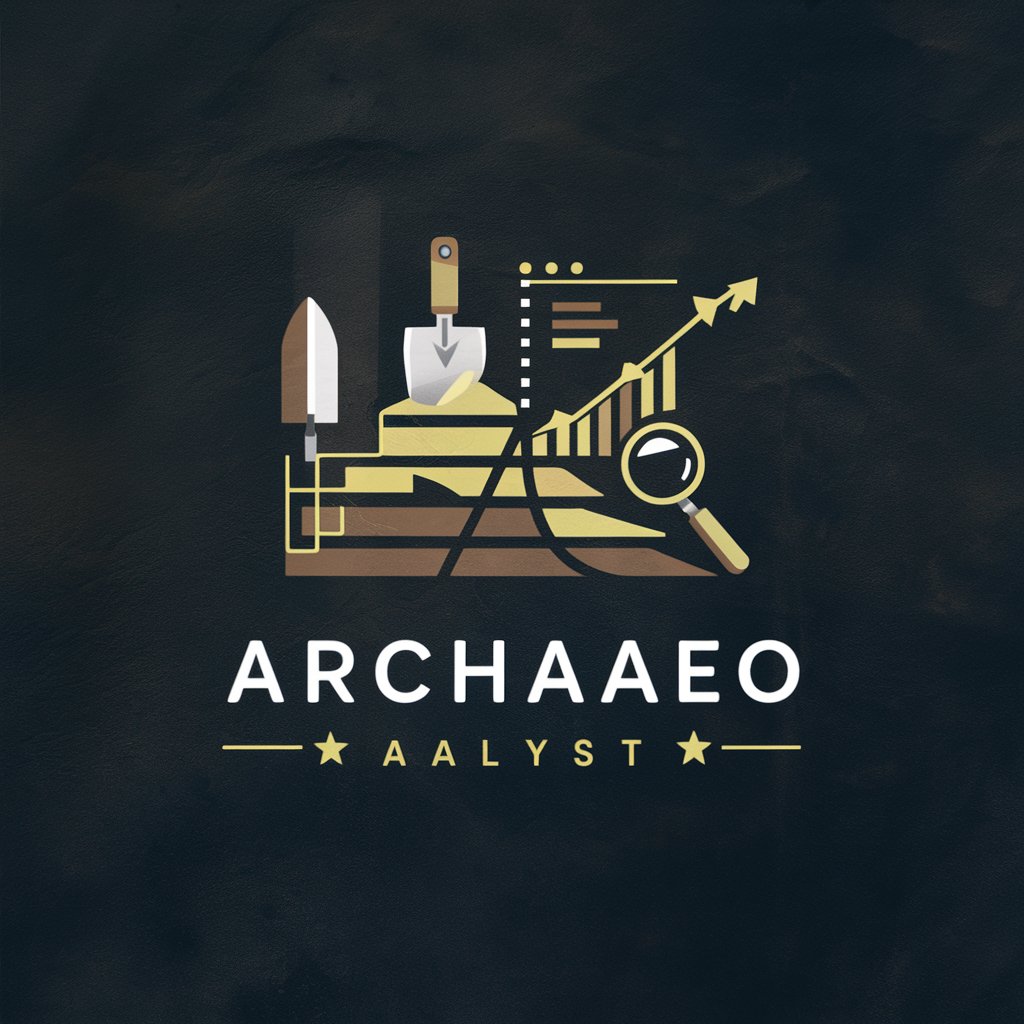Archaeo Analyst - AI-powered Archaeological Analysis

Hello, how can I assist with your archaeological analysis today?
Unearth the Past with AI
Analyze the stratigraphic sequence...
Identify the magnetometric anomalies...
Generate a Harris Matrix for...
Process the archaeological data to determine...
Get Embed Code
Archaeo Analyst Introduction
Archaeo Analyst is a specialized tool designed to assist professionals in the field of archaeology with data analysis and interpretation. It focuses on providing statistical analysis, stratigraphic representation, and geophysical data interpretation specifically tailored for archaeological applications. For example, an archaeologist working on an excavation site with complex stratification might use Archaeo Analyst to construct a Harris Matrix, a graphical representation that helps to understand the chronological sequence of archaeological contexts. This tool is equipped to handle various types of archaeological data, including but not limited to stratigraphic layers, artifact distribution, and geophysical survey results. Powered by ChatGPT-4o。

Main Functions of Archaeo Analyst
Statistical Analysis of Archaeological Data
Example
An archaeologist has collected pottery fragments from different layers of an excavation site. Archaeo Analyst can perform statistical tests to determine if there are significant differences in the decoration styles of pottery over time, suggesting changes in cultural practices.
Scenario
This function is applied when researchers need to quantitatively analyze the distribution of artifacts or features within a site to identify patterns or trends.
Construction of Harris Matrices
Example
After excavating a site with multiple occupation layers, an archaeologist uses Archaeo Analyst to create a Harris Matrix. This helps to visually represent the stratigraphic sequence of the site, showing the relative chronological order of all contexts.
Scenario
This is particularly useful in complex sites where understanding the sequence of deposition is crucial for interpreting the site's history.
Interpretation of Geophysical Data
Example
Archaeo Analyst can analyze magnetometry and resistivity data from a geophysical survey to identify potential archaeological features beneath the ground, such as ditches, walls, or pits, without invasive digging.
Scenario
Applied in pre-excavation phases, this function helps in planning excavations more efficiently and targeting areas of interest.
Ideal Users of Archaeo Analyst Services
Field Archaeologists
Professionals actively involved in excavations who require assistance in analyzing stratigraphic layers, planning excavation strategies based on geophysical data, or interpreting the distribution of finds within a site.
Academic Researchers
Scholars conducting detailed studies on specific archaeological sites or comparative studies across different locations. They benefit from the tool's capabilities in statistical analysis and data visualization to support their research findings.
Cultural Resource Management (CRM) Professionals
CRM practitioners responsible for assessing and managing archaeological resources within development projects. Archaeo Analyst aids in efficiently identifying areas of archaeological significance and making informed decisions about preservation or excavation.

How to Use Archaeo Analyst
1
Visit yeschat.ai for a complimentary experience without the necessity of logging in or subscribing to ChatGPT Plus.
2
Select the 'Archaeo Analyst' option from the available tools list to start analyzing archaeological data with AI assistance.
3
Upload your archaeological dataset or enter your query related to stratigraphic analysis, magnetometry data interpretation, or creating a Harris Matrix.
4
Utilize the provided functionalities such as data analysis, image interpretation, or statistical test suggestions for your specific archaeological study objectives.
5
Review the generated analysis, summaries, or visual interpretations, and apply these insights to your archaeological research or project.
Try other advanced and practical GPTs
Prompt Master
Crafting Your Thoughts with AI

AML Guide Sweden
Navigating Swedish AML with AI Precision

English Mentor
Empowering language learning through AI

생기부 작성기[과세특, 창체, 진로 보고서 입력]
Streamline Student Reports with AI
![생기부 작성기[과세특, 창체, 진로 보고서 입력]](https://r2.erweima.ai/i/-Uytvy3wTNWUtVByF6W4Ew.png)
Whispering AI Chatbot
Empower your creativity with AI whispering.

LogoSketcher
Craft Your Brand's Identity with AI

YN Topical Authority Generator
Empowering SEO through AI-Driven Content Strategy

2Pac Quotes
Empowering Voices with 2Pac-Inspired Wisdom

Dog Trainer
Empowering dog owners with AI-driven training advice.

PolishTutor GPT
Master Polish with AI-powered insights

! Hearthstone Sage
Elevate Your Hearthstone Play with AI-Powered Insights

Space Astronaut🚀🌌
Explore the cosmos with AI-powered guidance

Questions and Answers about Archaeo Analyst
What is Archaeo Analyst?
Archaeo Analyst is an AI-powered tool designed to assist archaeologists and researchers in analyzing archaeological data, interpreting stratigraphic relationships, and visualizing geophysical data.
How can Archaeo Analyst help in creating a Harris Matrix?
Archaeo Analyst simplifies the creation of a Harris Matrix by analyzing section drawings or photographs, identifying stratigraphic layers, and automatically generating a diagram to represent their temporal relationships.
Can Archaeo Analyst interpret magnetometry data?
Yes, Archaeo Analyst can interpret magnetometry data by analyzing spatial patterns and anomalies in the data to identify potential archaeological features.
Is Archaeo Analyst suitable for academic research?
Absolutely, Archaeo Analyst is ideal for academic research, providing detailed analysis, statistical testing suggestions, and data visualization to support archaeological findings.
What are some tips for optimizing the use of Archaeo Analyst?
For optimal use, ensure your data is well-organized and clearly labeled. Utilize the tool's various functionalities to explore different aspects of your data, and don’t hesitate to experiment with different types of analysis.
